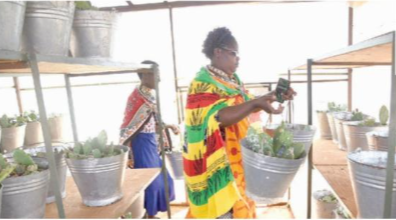Tiny insect wages war on invasive cactus

Their traditional dresses, accentuated by ornaments woven into their flapping capes under the scorching sun makes them standout.
As they gingerly walk across grazing lands in Doldol area of Laikipia County, it is the two metallic buckets they each carry, that distinguish them from the rest of the women in their community.
The buckets contain what is considered a weapon against a once ornamental invasive plant, Opuntia Stricta, which has now become a thorn in the flesh for pastoralist communities in the region.
Also known as the prickly pear or pear cactus, the native plant has invaded the limited amount of good grazing land left, brought diseases to livestock, displaced people and impoverished the economy of residents.
“The plants inhibit anything that grows around it, and overtime, it has taken over the rangelands, destroyed perennial grasses, as well as adaptable plants,” says Jacqueline Lenaloi, a researcher with Northern Rangelands Trust (NRT).
They have become a major threat to food security, biodiversity and the well-being of the community since they have a high ecological and competitive ability, as well as an efficient reproduction and dispersal mechanism.
“When livestock eat the cactus fruits, the small spines, called glochids, lodge in their mouths, throats, stomachs and intestines often causing infection and death. The large spines on the modified stems, called cladodes, often blind livestock by piercing their eyes as they try to access forage,” narrates Pauline Lipolei, resident Naibunga Upper conservancy.
Pauline Mamai is part of a group of women in Naibunga Upper conservancy, which is also home to several iconic animals, such as elephant, eland, oryx, giraffe, gerenuk, lion, cheetah, wild dog, Grevy’s zebra, common zebra and buffalo, have been trained by the NRT on ways to combat the spread of the plant.
Rangers believe young elephants are dying as a result of feeding on the cactus fruit. Opuntia stricta also displaces native plant species and prevents rehabilitation of degraded land.
Children who consume the sweet, bright purple Opuntia fruit in large amounts suffer from constipation amongst other illnesses.
Some studies indicate the cactus has taken over 50 to 75 per cent of communal grazing fields in Laikipia County. It is listed among the 100 worst invasive alien species by the International Union for Conservation of Nature.
Chemical control by using herbicides and mechanical control by cutting down individual cactus plants have been tried to combat the plant, but the methods posed challenges in terms of expense, environmental impact and practicality.
However, another way exists, NRT has partnered with women within the conservancy to introduce cochineal, a sap-sucking insect, which sucks fluid from the Opuntia Stricta and once the plant is dead, the insect migrates through wind dispersal to the next plant.
The insect, which was imported from South Africa and being reared in greenhouses in the larger Laikipia County is distributed in numbers to teams of 15 women who often work on a rotational basis to smear them on the plants.
“We smear the cochineal on the Opuntia and after two weeks, we repeat the process. This will allow the insects to consume the plant, eventually destroying it,” says Mamai.
“Women are readily available to work and they are passionate about this project because when you talk of all this livestock effects, it is the women that suffer the most, and take the children to hospital when they fall sick,” she adds.
The group of women earn Sh500 at the end of each task and are able to support their families.
“Scientifically, Opuntia grows vegetatively meaning, if it drops anywhere it will live, it needs little water to grow. Elephants are probably the number one dispersers, because they feed on 2,000 seeds per day and can travel up to 2,000 kilometres before defecating, livestock and Olive Baboons also feed on it and are spreaders,” said Mamai.
George Olesentari, who has been combating the plants since the 1950s says that he has lost scores of his livestock to the plant.
“I am glad the Cochineal insect is assisting in eradicating them but we need to conduct this extermination on a much larger scale,” he said.
“We are trying to get coordinates of where to do the spread and maybe in the next five or 10 years we will have dealt with this menace, and hopeful kick off a proper rehabilitation exercise of those rangelands,” said Alex Teiyo, a resident of Naibunga Upper Conservancy.











